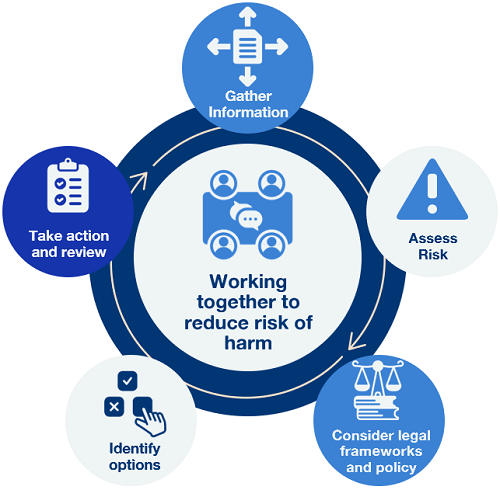Risk assessments and interventions
Risk assessment
One key challenge is to ensure that agencies reach a shared understanding of whether thresholds for collective concern and action are reached. It is important to undertake a risk assessment that considers an individual’s preferences, histories, circumstances, and lifestyle to achieve a proportionate and reasonable tolerance of acceptable risks.
While there are no objective measures of self-neglect, the use of resources such as clutter-rating images can be helpful in determining the scale and level of self-neglect, and shared risk assessment tools are helpful in evaluating levels of risk.
A risk assessment will help to inform whether there are immediate actions that need to be taken, for instance where someone’s life is at risk. The starting point however for most interventions should be to encourage the person to do things for themselves. This approach should be revisited regularly throughout the period of the engagement, and any risk assessment should be shared with relevant partners and the adult at risk. All efforts and the responses of the person to this approach should be recorded fully.
Download our self-neglect risk assessment template (DOCX, 32.41KB)
Interventions
Self-neglect presents in a number of different ways, and each case will require tailored interventions. Research evidence has shown that whichever methods are used to intervene in self-neglect, building a relationship of trust is the key to successful negotiation to implement measures that reduce risk and improve wellbeing. Practical help can also be valuable.
Self-neglect practice involves a complex interaction between 'Knowing, Being and Doing' - integrating knowledge, skills and use of self.

Knowing: The person and their history. Professional knowledge.
Being: Respect, empathy, reliability, honest and care, being present, keeping company, being human.
Doing: Hand-off and hands-on balance, building consensus over small steps while negotiating larger ones, deciding when intervention is essential.
To access tools to support your planning and interventions, take a look at RIPFA's self-neglect practice tool (PDF, 649KB).
Multi-agency responses
Successful responses to self-neglect require involvement and collaboration of different agencies and practitioners. Safeguarding Adults Reviews have frequently identified failings in multi-agency coordination as contributing to negative outcomes for individuals, so it is important to ensure structures are put in place to support effective multi-agency working.
Multi-agency meetings are often the best way to ensure effective information sharing and communication, and a shared responsibility for assessing risks and agreeing an action plan. Ensuring meetings with a clear agenda for discussion are convened promptly when the initial concerns are raised, should be considered standard practice, to offer an effective response to the adult.

When working together to reduce risk of harm, agencies can follow and repeat the following process:
- Gather information
- Assess risk
- Consider legal frameworks and policy
- Identify options
- Take action and review
Download a template to guide multi-agency responses and planning (DOCX, 64KB)
Home fire safety visits (HFSV)
Where a person’s home environment becomes cluttered through the excessive hoarding of items, the risk of a fire occurring increases, and it is more difficult for adults living within the property to evacuate safely. It can also impact on the safety of those living nearby. Partners and agencies who work or engage with very high-risk people should refer them immediately for a HFSV.
A new 24-hour phone number is available for this purpose and agencies can call 020 8536 5955 to book an immediate HFSV. This will ensure that the concern will be addressed within 4 hours.
LFB would categorise an individual as being very high risk if they have all of the following 6 characteristics:
- smoker
- living alone
- over 60 years old
- in receipt of care (informal, formal or both)
- no working smoke alarms in their home
- user of mobility aids, or chair/bed bound
A very high-risk individual can also be identified if they are at risk or are a victim of arson.
In all other cases where it is felt that a HFSV is needed, partner agencies should call 0800 028 4428, where they will be asked a series of triage questions to determine the risk, which will determine how quickly the person receives a HFSV from a local crew.
Not everyone will need a home visit, and those who fall into a lower-risk category can use the online Home Fire Safety Checker.
To access more support and information around home fire safety visits, see our home fire safety guide.
Escalation and management oversight
Should the risks remain significant or increase following usual multi-agency responses, or where there are inter-agency disputes, concerns should be escalated via usual operational management routes. Management oversight will support practitioners to clarify their thinking, be clear about potential risks and aims, and be supported to discuss issues.
Where there is a need to escalate concerns within partner agencies, line managers or safeguarding leads should liaise with their equivalent in the other agency, with consideration of relevant legislation, policies, procedures and guidance. Where necessary, this may be escalated further within management structures.
We should seek to achieve a timely resolution at the earliest opportunity, and any immediate risks should be addressed regardless of any ongoing disputes.
At all times, we must also ensure that the person is at the centre of the process, their voice is heard and wherever possible their views and wishes inform the actions taken.
Role of the High-Risk Panel
Where a case is particularly complex and where professionals feel stuck with what to do next, a referral to the high-risk panel may be appropriate. The panel will consider case presentations for situations that have already been considered within partner agencies' risk assessment processes and multi-agency frameworks, and where there remains a significant risk.
This could include risk within the following areas:
- home fire safety
- unwillingness or inability to tend to personal care, health and living conditions
- ongoing needs or behaviour that places a person at significant risk
Visit the Multi-agencies panel page on the H&F website to view the full terms of reference for the High-Risk Panel and access the referral form.
